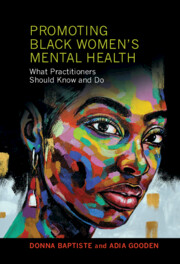Book contents
- Promoting Black Women’s Mental Health
- Promoting Black Women’s Mental Health
- Copyright page
- Contents
- Figures
- Tables
- Contributors
- Introduction
- Part I Black Women in Context
- Part II Therapy Contexts
- Part III Core Themes in Black Women’s Stress and Distress
- Part IV Helping Black Women Recover and Thrive
- 13 Improving Black Women’s Physical Health and Wellness
- 14 Black Women’s Inner Healing and Resources for Thriving
- 15 Black Women’s Spiritual and Religious Coping
- Conclusion
- Appendix
- Index
- References
14 - Black Women’s Inner Healing and Resources for Thriving
from Part IV - Helping Black Women Recover and Thrive
Published online by Cambridge University Press: 22 June 2023
- Promoting Black Women’s Mental Health
- Promoting Black Women’s Mental Health
- Copyright page
- Contents
- Figures
- Tables
- Contributors
- Introduction
- Part I Black Women in Context
- Part II Therapy Contexts
- Part III Core Themes in Black Women’s Stress and Distress
- Part IV Helping Black Women Recover and Thrive
- 13 Improving Black Women’s Physical Health and Wellness
- 14 Black Women’s Inner Healing and Resources for Thriving
- 15 Black Women’s Spiritual and Religious Coping
- Conclusion
- Appendix
- Index
- References
Summary
As discussed throughout the book, Black women experience racial trauma and discrimination and may internalize these messages and become highly self-critical. These experiences can lead to feelings of low self-worth, anxiety, and depression. In this chapter, we share the strategies of self-compassion, self-forgiveness, and self-love and acceptance to support Black women in emotional healing. We also discuss the use of the arts and religion and spirituality as resources for Black women’s healing and thriving.
Keywords
- Type
- Chapter
- Information
- Promoting Black Women's Mental HealthWhat Practitioners Should Know and Do, pp. 336 - 356Publisher: Cambridge University PressPrint publication year: 2023



